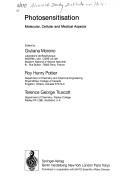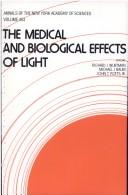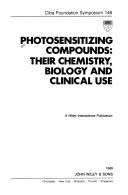| Listing 1 - 10 of 22 | << page >> |
Sort by
|
Book
ISBN: 084935370X Year: 1983 Publisher: Boca Raton CRC
Abstract | Keywords | Export | Availability | Bookmark
 Loading...
Loading...Choose an application
- Reference Manager
- EndNote
- RefWorks (Direct export to RefWorks)
Immunology --- Photobiology --- Photosensitization, Biological

ISBN: 3540185542 0387185542 3642731538 3642731511 Year: 1988 Volume: vol 15 Publisher: Berlin Heidelberg New York Springer
Abstract | Keywords | Export | Availability | Bookmark
 Loading...
Loading...Choose an application
- Reference Manager
- EndNote
- RefWorks (Direct export to RefWorks)
Cancer --- Treatment --- Congresses --- Photosensitization [Biological ] --- Photochemotherapy
Book
ISBN: 1536119326 9781536119329 9781536119121 Year: 2017 Publisher: New York
Abstract | Keywords | Export | Availability | Bookmark
 Loading...
Loading...Choose an application
- Reference Manager
- EndNote
- RefWorks (Direct export to RefWorks)
Photochemotherapy. --- Photodynamic therapy --- Chemotherapy --- Photosensitization, Biological --- Phototherapy
Book
ISBN: 1596932783 9781596932784 9781596932777 1596932775 Year: 2008 Publisher: Boston Artech House
Abstract | Keywords | Export | Availability | Bookmark
 Loading...
Loading...Choose an application
- Reference Manager
- EndNote
- RefWorks (Direct export to RefWorks)
This resource brings you the latest advances in photodynamic therapy and offers you a solid understanding of the design, delivery and dosimetry of the three basic ingredients of PDT-photosensitizers, light and oxygen. The book covers novel areas of mechanistic and innovative translational approaches.
Photochemotherapy. --- Photodynamic therapy --- Chemotherapy --- Photosensitization, Biological --- Phototherapy --- Photochemotherapy

ISBN: 0824756770 9780824756772 Year: 2004 Publisher: New York: Dekker,
Abstract | Keywords | Export | Availability | Bookmark
 Loading...
Loading...Choose an application
- Reference Manager
- EndNote
- RefWorks (Direct export to RefWorks)
Photosensitivity Disorders --- Ultraviolet Rays --- Skin --- Photosensitization, Biological --- Ultraviolet radiation
Book
ISBN: 1283856727 3110276135 9783110276138 9783110275940 3110275945 9781283856720 Year: 2012 Publisher: Berlin De Gruyter
Abstract | Keywords | Export | Availability | Bookmark
 Loading...
Loading...Choose an application
- Reference Manager
- EndNote
- RefWorks (Direct export to RefWorks)
Extracorporeal photopheresis (ECP) is the first FDA approved cellular photoimmunotherapy for cancer, namely cutaneous T-cell lymphoma, and has demonstrated efficacy in various diseases that have a suspected involvement of pathogenic T-cells including prevention and treatment of acute and chronic graft-versus-host disease, organ transplant rejection, selected autoimmune diseases and Sezary syndrome. In ECP, patient's blood mononuclear cells are collected, exposed to ultraviolet light in the presence of extracorporeally administered liquid 8-methoxypsoralen and reinfused. Besides its considerable efficacy ECP has an exceptional safety profile, does not cause general immunosuppression and thus, does not increase risk of infectious complications and relapse of malignant disease. Exciting preclinical data and clinical observations provide insight into the mechanisms of action of ECP and support its immunomodulatory role. This book will provide an overview on the historical development of ECP, technical aspects for its use in various patient populations including children and adults, novel research findings both in preclinical models and in various patient cohorts and will stimulate further research in organ, tissue and cell transplantation and autoimmune disorders.
Photochemotherapy. --- Cancer --- Cancer therapy --- Cancer treatment --- Photodynamic therapy --- Chemotherapy --- Photosensitization, Biological --- Phototherapy --- Treatment. --- Therapy
Book
ISBN: 1839165588 1839165596 9781839165597 Year: 2022 Publisher: Cambridge Royal Society of Chemistry
Abstract | Keywords | Export | Availability | Bookmark
 Loading...
Loading...Choose an application
- Reference Manager
- EndNote
- RefWorks (Direct export to RefWorks)
Written in an accessible and comprehensive manner, DNA Photodamage will appeal to all scientists working in the area whether specialists in the discipline or not and provides a complete coverage of the field, from ultrafast spectroscopy to biomedical research.
DNA damage. --- Photosensitization, Biological. --- Ultraviolet radiation --- Light --- Solar radiation --- Physiological effect.

ISBN: 0897663012 0897663004 9780897663014 Year: 1985 Volume: 453 Publisher: New York (N.Y.): New York Academy of Sciences,
Abstract | Keywords | Export | Availability | Bookmark
 Loading...
Loading...Choose an application
- Reference Manager
- EndNote
- RefWorks (Direct export to RefWorks)
Light --- Photoperiodism --- Photosensitization, Biological --- Physiological effect --- Congresses --- Biological photosensitization --- Chemicals --- Drugs --- Photobiology --- Biological rhythms --- Electromagnetic waves --- Light sources --- Spectrum analysis --- Physiological effect&delete& --- Light - Physiological effect - Congresses --- Photoperiodism - Congresses --- Photosensitization, Biological - Congresses

ISBN: 0471923087 Year: 1989 Volume: vol 146 Publisher: Chichester New York Toronto Wiley
Abstract | Keywords | Export | Availability | Bookmark
 Loading...
Loading...Choose an application
- Reference Manager
- EndNote
- RefWorks (Direct export to RefWorks)
Photosensitization [Biological ] --- Therapeutic use --- Testing --- Congresses --- Cancer --- Photochemotherapy --- RADIATION-SENSITIZING AGENTS --- PIGMENTS HEMATOPORPHYRINS --- PORPHYRINS --- PHOTOCHEMOTHERAPY --- NEOPLASMS --- xxx --- PHOTOSENSITIVITY DISORDERS --- CHEMICALLY INDUCED
Book
ISBN: 1624176607 9781624176609 9781624176357 1624176356 Year: 2013 Publisher: New York Nova Biomedical
Abstract | Keywords | Export | Availability | Bookmark
 Loading...
Loading...Choose an application
- Reference Manager
- EndNote
- RefWorks (Direct export to RefWorks)
"Photodynamic therapy (PDT) is currently clinically employed to treat several malignant and nonmalignant diseases. With approvals for various applications by health agencies in Europe, the US, Canada, and Japan, PDT represents the method of choice for treatment of age-related macular degeneration and is appreciated as a minimally invasive therapeutic procedure to treat skin, esophageal, head and neck, lung, and bladder cancers with high cure rates, nearly no side effects, and excellent cosmetic outcomes. Current basic research and clinical studies will help to further integrate PDT as a mainstream procedure for cancer treatment. This book presents an overview of the important medical applications of PDT, including approved treatments, clinical trials, and investigated therapies for cancer and non-malignant diseases."--
Phototherapy. --- Photochemotherapy. --- Photodynamic therapy --- Chemotherapy --- Photosensitization, Biological --- Phototherapy --- Actinotherapy --- Finsen rays --- Finsen therapy --- Light --- Light therapy --- Physical therapy --- Therapeutics, Physiological --- Thermotherapy --- Radiotherapy --- Therapeutic use --- Physiological effect
| Listing 1 - 10 of 22 | << page >> |
Sort by
|

 Search
Search Feedback
Feedback About UniCat
About UniCat  Help
Help News
News